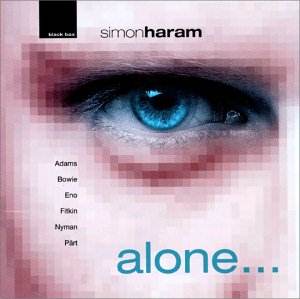SIMON HARAM alone…
John ADAMS
Consuelo's Dream
This is Prophetic
Alone…again or at last
David BOWIE & Brian ENO
Warsawa
Graham FITKIN
Bob
Watching
Pam & Jim & Jim & Pam
Michael NYMAN
If
Why
Arvo PART
Spiegel im Spiegel
 Simon Haram (alto and soprano
saxophone, EWI, synths); Liz Burley (piano, Fender Rhodes); Ann Morfee (violin);
Ian Humphries (violin); Bruce (SS) White (viola); Tony Hinnigan ('cello);
Martin Elliot (bass guitar); Will Gregory (Korg MS20 & Vox Continental);
Rob Farrer (vibes).
Simon Haram (alto and soprano
saxophone, EWI, synths); Liz Burley (piano, Fender Rhodes); Ann Morfee (violin);
Ian Humphries (violin); Bruce (SS) White (viola); Tony Hinnigan ('cello);
Martin Elliot (bass guitar); Will Gregory (Korg MS20 & Vox Continental);
Rob Farrer (vibes).
Executive Producer: Chris Craker.
 BLACK BOX BBM1018,
1999
[57.23]
BLACK BOX BBM1018,
1999
[57.23]
Crotchet
AmazonUK
AmazonUS

Despite the quite disparate collection of composers on this disc, this selection
of music works very well as a programme and manages to stress some obvious
similarities between aspects of their style. The listener is made very much
aware of shared post-minimalist characteristics. None of the music is complex
in style or structure and is easily accessible on a single hearing and some
listeners may even be tempted to apply the "New Age" epithet to a few of
the tracks. The ensemble provides a pleasing blend of acoustic, amplified
and electronic instruments in assured and effective arrangements by Haram
himself, skilfully mastered to produce a consistent sound aesthetic throughout.
The three pieces by John Adams represent his more contemplative side (definitely
no fast rides!) and are all arrangements of music from two of his operas,
exploiting the oft-cited parallels between saxophone and voice. Consuelo's
Dream has a gently rocking feel with a central section of more metrical
regularity whilst Alone …again or at last presents simple, pleading
phrases from the soloist over a keyboard background of slow moving "altered"
chords, producing an effect reminiscent of cool jazz (but with none of the
breathiness that a Getz might have brought to the sound). This is
Prophetic (from Nixon in China) features an ensemble for strings
and piano using richly harmonic pulsations in a typically post minimalist
tonality above which Haram weaves his smooth melodic lines.
Arvo Pärt's contribution, Spiegel im Spiegel is typically economical
and spare in its material (in keeping with the composer's putative tag of
"faith minimalist") although this arrangement provides a certain lushness.
Dominated by repetitive triadic figures from the vibraphone and slow step-wise
notes from the saxophone, the piece could be perceived as either hypnotic
or just uneventful, according to taste, but it does manage two climaxes of
dynamic and pitch (both go up).
The two pieces by Michael Nyman, If and Why (from The Diary
of Anne Frank) are also predominantly contemplative, both featuring a
regular (but not "chugging") pulsation and tonally based progressions (delivered
via simple piano chords in If). In the case of Why,
practically everything is "neo" - neo tonal, neo romantic as well as neo
baroque, the string writing, in particular, creating the latter impression.
Here structure is enhanced by a build up of increasingly rich textures. Again,
slow melodic patterns, featuring long notes, inform the solo saxophone part
which blends in beautifully with the overall texture. Long, slow saxophone
melodies are, yet again, a feature of the offering by David Bowie and Brian
Eno, Warsawa. As with Why, the listener experiences another
slow-but-sure build up, at the climax of which the saxophone gets closer
to "screaming" than anywhere else on the album. However, the neo-tonality
of Nyman is here replaced by a strong modal flavour.
The album also includes three compositions by Graham Fitkin, the most substantial
of which, Watching, presents a simple ternary structure featuring
A dorian in the outer sections with the now-to-be-expected long, slow melodic
lines from the soloist, repeated notes lending a gentle insistence to the
phrases. Bob is an all-acoustic number, a trio for saxophone, piano
and 'cello in which the parts blend well and the music's innate charm is
aided by the clarity of the arrangement. Although the basically unpretentious
melodic material of Pam & Jim & Jim & Pam is of a piece
with the rest of the album, in other respects this track is the odd one out,
being the only one featuring an unaccompanied saxophone solo and the only
track that displays Haram's dexterity on his instrument.
Overall this disc has a beguiling, nostalgic quality which is most appealing.
The richly reverberant sound is well suited to the mood although, in the
case of Pam & Jim & Jim & Pam, clarity in the faster passages
might have been aided by cutting this back just a little. It provides a most
pleasing and restful experience which is designed to please rather than to
challenge. It is doubtful that any of the performers were greatly challenged
either, the chief demands being those of phrasing and tone control which,
when all said and done, can be taken for granted from players of this calibre.
However, Haram's sound is always smooth, stylish and consistent; fully in
sympathy with the chosen aesthetic of the CD.
Julian Hellaby

